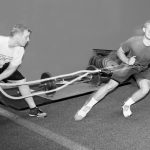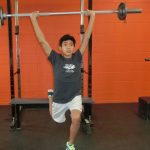4 Qualities of Optimizing Strength: Part 4-Rate of Force Development
At F2P we believe a well-designed performance training program should center around increasing an athlete’s efficiency and ability for the movements that their sport requires. When looking at the majority of sport movements there are 4 qualities that work together to optimize strength for those movements. The first quality is Eccentric Ability, how well does your muscle work like a rubber band when stretching. The second is Yielding Strength, how well does your body resist/absorb force to be stable. The third is Reactive Strength, what is your muscle’s ability to go from a stretching action to a shortening action. And the fourth quality is Rate of Force Development (RFD), how fast and with how much force can your muscles create movement. One thing to note is all of this is joint and body specific, and will always happen. We are trying to make each quality more efficient thus making the athlete more explosive, powerful, and safer.
This blog post will focus on “Rate of Force Development”.
Rate of Force Development (RFD) is the rate of change of the force in the time it’s produced. Or more simply how much force and how quickly the muscle can contract. Factors that affect this are Maximum Strength, Starting-Strength, Acceleration-Strength and Explosive Strength. If an athlete can effectively change the RFD of their muscles it will lead to quicker actions in their athletic movements.
Here is a quick overview of each factor mentioned:
Maximum strength is the maximum voluntary force your body can produce. The amount of force you are trying to voluntarily move will vary with the task at hand. Moving an object such as a stick, club, ball, or racket doesn’t require the maximum amount of force your body can produce. However, having to move one’s body, as coming in and out of a stance, or having to move an opponent’s mass will require a greater amount of strength needed for that task. Therefore increasing maximal strength could enhance performance if the athlete doesn’t have an optimal amount of sufficient strength for that task.
Starting-Strength is the ability of the muscles to develop force PRIOR to moving an object (or body). If an athlete can develop a high amount of force in the working muscles PRIOR to moving out of a given position efficiency the speed of the action could be enhanced. If you have ever noticed an athlete slowing coming out of their stance but once they get moving they tend to pick up speed they could be lacking starting-strength.
Acceleration-Strength is the ability of the muscle to continue to build up speed of the action as rapidly as possible once the action begins. For instance, when an athlete is running or jumping, do the hips continue to pick up speed through the extension phase or do the hips tend to stay the same speed or even slow down during the extension phase. If the latter is the case the athlete will benefit from increases to their acceleration-strength.
Explosive Strength is the ability to produce a high amount of force in a minimal amount of time. This is what most athletic movements require to be more efficient. If you are looking to increase your athletic movement, you are going to have to create more force in a shorter amount of time.
In my experience, I have found that a lot of issues with RFD start with body positioning (joint relationships) and stability. Just by changing the position that an athlete starts from and gets into can change their RFD drastically. For example, it isn’t uncommon for athletes that I have worked with to increase their pause jump squat which can be used as a measure of RFD (holding in a static position at the bottom of their jump for 3 seconds before extending) 2+ inches in a session or two. The reasons for this increase could vary from being in a more optimal position to activating the correct muscles to creating a faster start of the initial movement. No matter the case, if the position isn’t changed long-term continually improvement won’t be maximized.
These are the factors that I look at from a training standpoint. Yes, if you increase an athlete’s eccentric ability their RFD will increase as well. However, from a training standpoint and when looking at an athlete individually to see where their deficiencies are I separate the two actions, at least to begin with. Every situation will be different. The amount of importance that RFD will play in the success for an athlete will depend on several things including the sport, the position, and the individual’s strengths and weakness.
References
Verkhonshanky, Y. and Siff, M. Supertraining. Ultimate Athlete Concepts, 2009.





